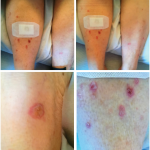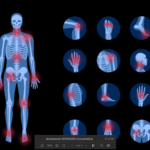Sung et al reported a case of idiopathic PFPAS in a 31-year-old Korean woman who was successfully treated with corticosteroids.1 Her PFPAS was not found to be associated with malignancy during the 24-month follow-up period from the onset of her first symptoms.
Conclusion
Our patient has continued to remain healthy, and she has shown no evidence of malignancy over the relatively short time period of 10 months since her symptom onset. Perhaps a positive indication that she may be neoplasm free is her rapid improvement on corticosteroids and the normalization of her CRP. This rare case, with its characteristic hand deformities, should alert the clinician to a diagnosis of PFPAS, and clinicians should also be aware of its usual paraneoplastic association.
Naveen Raj, DO, MPH, is a second-year rheumatology fellow in the Department of Rheumatology at Larkin Community Hospital/Nova Southeastern University in Fort Lauderdale, Fla.
Marc Kesselman, DO, FACOI, FACC, is a second-year rheumatology fellow in the Department of Rheumatology at Larkin Community Hospital/Nova Southeastern University.
Barry Waters, MD, is a clinical professor of medicine at Nova Southeastern University and program director of rheumatology fellowship at Larkin Community Hospital/Nova Southeastern University. He is also a rheumatologist at Arthritis Specialists PA in Coral Springs, Fla.
References
- Sung YK, Park MH, Yoo DH. Idiopathic palmar fasciitis with polyarthritis syndrome. J Korean Med Sci. 2006;21:1128–1132.
- Medsger TA, Dixon JA, Garwood VF. Palmar fasciitis and polyarthritis associated with ovarian carcinoma. Ann Intern Med. 1982 Apr;96(4):424–431.
- Yogarajah M, Soh J, Breck L, et al. Palmar fasciitis and polyarthritis syndrome: A sign of ovarian malignancy. J R Soc Med. 2008;101:473–475.
- Mahoney K, Cayea D, Li Q, et al. A handy clue: Palmar fasciitis and polyarthritis syndrome. Am J Med. 2014 Feb;127(2):116–118.
- Martorell EA, Murray PM, Paterson JJ, et al. Palmar fasciitis and arthritis syndrome associated with metastatic ovarian carcinoma: A report of four cases. J Hand Surg Am. 2004 Jul;29(4):654–660.
- Seaman JM, Goble M, Madsen L, et al. Fasciitis and polyarthritis during antituberculous therapy. Arthritis Rheum. 1985 Oct;28(10):1179–1184.



